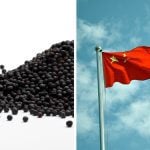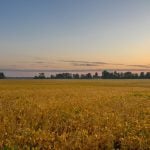Agriculture and Agri-Food Canada (AAFC) on Sept. 14 announced changes to Canada’s farm programs for 2013. While several details have yet to be nailed down or announced, it is clear that these changes will mean a less lucrative program for Canadian farmers.
For the past few months, farmers have been aware of the federal government’s intentions to decrease AgriStability coverage from 85 to 70 per cent of reference margins. However, other program changes will also have significant impacts. Make sure you know the impact on your farm before you decide whether or not to pay premiums and sign up for the program.
Read Also

China seeks improved ties with Canada amid rising trade tensions
China called on Friday for steps to improve bilateral ties with Canada, saying there were no deep-seated conflicts of interest, following a spike in trade tensions with many of Beijing’s Western trade partners this year.
Limited reference margins
The change to using what AAFC’s press release calls a “limited reference margin” is important, especially for grain and oilseed farmers.
AgriStability payments are based on a farm’s historical “production margins” — rough estimates of farm profit calculated by subtracting “allowable” expenses from “allowable” income. A farmers’ program “reference margin” (the amount protected by the program) is calculated using the Olympic average of production margins from the past five years (subtracting the highest and lowest numbers and averaging the remaining three).
For 2013, AAFC will change the way your reference margin is calculated. You’ll be limited to the lower of your production margin or your allowable expenses. While AAFC has not yet announced details, a spokesman said they are leaning toward looking at each of your past five years of data, choosing the lower of your production margin or your allowable expenses, and then re-calculating your Olympic average using the new numbers.
At first, this change doesn’t seem particularly important. You wouldn’t expect your profits to be a lot higher than your expenses — grain farming doesn’t exactly have a reputation as a high-margin business.
However, the limitation doesn’t apply to all of what you might think of as expenses — it applies to AgriStability’s “allowable” expenses. Allowable expenses are only costs directly related to production. They do not include items like machinery repairs, land rental, interest costs, or depreciation. Some consultants estimate that 60 to 70 per cent of expenses are “allowable” under this program. There are noble reasons for excluding these expenses — the program was designed specifically to avoid influencing management decisions like ‘Should I lease or buy a tractor’? or ‘Should I buy or rent land?’ — but the key is that they are only variable expenses, like seed and chemicals.
Impact on the farm
AAFC has not released any statistics or forecasts to explain how this change might impact farmers. Accountants are reluctant to speculate on record without more concrete details available.
But a quick look at the most recent AgriStability statement we’ve received on our farm indicates that this change will make a big difference to us. My husband and I operate a pedigreed seed farm, about 4,600 acres, in southeastern Saskatchewan. We think our production and sales experiences are reasonably typical for our area.
Our recent AgriStability statement includes data from 2006 to 2010. In three of these five years, our allowable expenses are lower than our production margins.
Looking at our statement, I considered each year in our five-year history and chose the lower of the “total allowable expense” or our “adjusted production margin,” then calculated our new Olympic average (by eliminating the highest and lowest years and averaging the remaining three). This number, our new “limited reference margin,” is 23 per cent lower than our previous reference margin.
There are different ways that AAFC could chose to implement this change. This straightforward approach I considered would mean a significant decrease in the value of AgriStability on our farm; other approaches would decrease our coverage by slightly different amounts. And these decreases come before we consider the other program changes.
No more tiers
For a quick, simplified understanding of AgriStability, let’s take a look at an example straight from the program brochure. The farmer in the example has a reference margin of $100,000. In a claim year, that farmer has a “program year margin” of only $35,000. Because the program covers 85 per cent of his margin, you might imagine that this premium-paying farmer could look forward to a $50,000 cheque ($85,000 – $35,000). Not so.
Instead, there are two tiers of payments (well, actually three, but let’s ignore negative margins for now). For the first tier of the payment, the program pays 80 per cent of losses, up to 70 per cent of his margin. In the example, 70 per cent of his $100,000 margin is $70,000. Because he already has a program year margin of $35,000, our farmer is $35,000 short of the $70,000 mark. So, for this tier, he receives $28,000 (80 per cent of $35,000).
The second tier covers his margin from 70 to 85 per cent (from $70,000 to $85,000 in the example). The program covers losses in this range at 70 per cent. For our farmer, this is a range of $15,000; our farmer’s payment in this tier is $10,500 (70 per cent of $15,000).
So, in total, our farmer receives a total AgriStability payment of $38,500. Added to his program year margin of $35,000, this brings him up to $73,500, just a bit more than 70 per cent of his reference margin.
As well as moving the coverage level from 85 to 70 per cent, announced program changes will eliminate the confusion of different payment tiers. Our sample farmer would simply receive coverage of 70 per cent of his program margin. That is, 70 per cent of the difference between his protected reference margin ($70,000) and his program year margin ($35,000). Seventy per cent of $35,000 is $24,500.
This is a much lower payment than before (largely because of the drop from 85 to 70 per cent), but at least it’s easier to explain.
Negative margins
These changes will be less harsh for farmers with negative margins. Previously, while the program paid out 70 and 80 per cent of positive program margins, AgriStability only covered 60 per cent of negative margins.
If the farmer in our example had a negative margin of -$20,000 in the claim year (as compared with +$35,000 in the example), he would receive a payment made up of three tiers:
- Tier one: 60 per cent of his negative margin ($20,000) = $12,000
- Tier two: 80 per cent of 70 per cent of his reference margin ($100,000) = $56,000
- Tier three: 70 per cent of the difference between 70 and 85 per cent of his reference margin ($100,000) = $10,500
His total payment would be $78,500.
The math is simpler with the program change. He would now receive 70 per cent of 70 per cent of his program margin (70 per cent of $70,000), plus 70 per cent of his loss (70 per cent of $20,000), for a total payment of $63,000.
However, keep in mind that, in order to generate a negative margin, that farmer would have to have “allowable” expenses greater than his sales. This is much more severe than a typical farm loss you might see on an accounting statement that includes rent, machinery repairs and depreciation.
And, currently there are a few other caveats to negative margin payments. According to AAFC’s website: two of the three production margins used to calculate your Olympic average must be positive; you must have used sound management practices; and circumstances of your negative margin must have been beyond your control.
The value of the program
The most common complaints about the existing version of AgriStability have been that it’s too complex and not timely enough. That describes our experience. Last year, we had no production on our farm. Spring flooding in 2011 kept us out of the field until it was much too late to seed and expect a crop.
Now, 16 months after the flood, we still have no idea how much, if anything, we’ll receive from AgriStability. To be fair, some of this delay is attributable to our corporation year end date. But with the program impacts of structural changes and calculations for allowable expenses, we can’t make any educated guess about the size of our 2011 payment. For this reason, the program is already of less value to us than Crop Insurance, which paid out incredibly quickly when we were unable to seed, or AgriRecovery, which gave us a prompt payout when we faced disaster. We are very grateful for both of those programs.
If AgriStability works the way we hope it will, and we receive a payment that helps us recover from 2011, my husband and I may yet be the loudest advocates of AgriStability on the Prairies.
But a lower than expected payment (or no payment at all), combined with these new changes that lower the value of the program, may mean the end of our participation in AgriStability in 2013.
— Leeann Minogue is editor of Grainews at Griffin, Sask.
Related stories:
Ag groups wary of GF2’s risk management funding cuts, Sept. 14, 2012
Ottawa seeks heavier trigger pull on AgriStability: report, July 10, 2012
Ontario dissents on plans for Growing Forward sequel, July 10, 2011
















